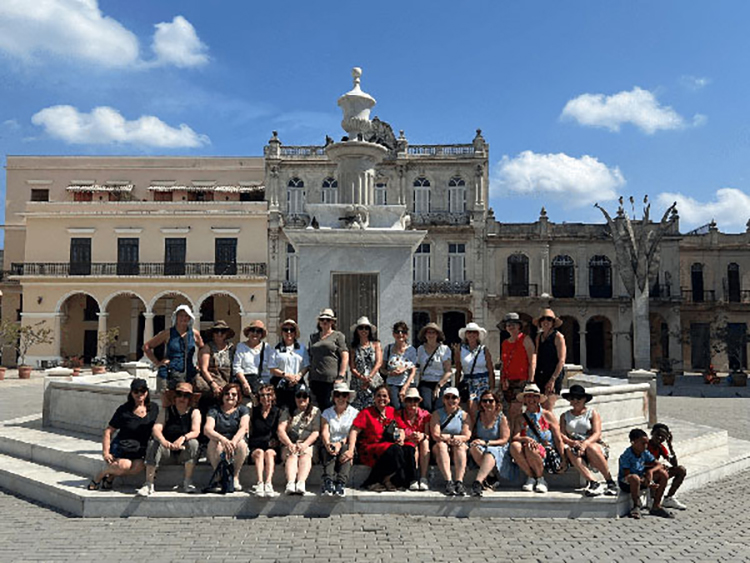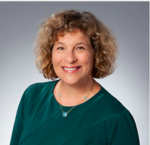
By Heidi Gantwerk

SAN DIEGO — Nine days ago, I was preparing for Shabbat in what felt like another world, in Havana with our Federation Women’s Mission to Cuba. The U.S. Chargé d’Affaires told us that it is impossible to explain Cuba if you haven’t been there, and I find myself trying, over and over again, to communicate what it’s like.
Being almost totally offline for four days allowed for a completely different feeling of presence, of being in the moment, and ensured that the women travelling together connected on a deep level with each other and with the Cubans we had the good fortune to meet. Together, we drank mojitos, rode in colorful old convertibles, and even tried cigars (which go down a little better with Cuban rum).
But we also dug much deeper; into political history and current confounding political realities, into the economy, the social structure, and of course, the Jewish community – or what is left of it. We spoke to Cubans about their daily, enormously difficult lives. And we celebrated Shabbat with a dwindling congregation with nothing but old matzah to bless – there was no flour that week. But we all knew the same prayers and sang the same melodies, reminding us once again that we truly are one people.
I returned overwhelmed by gratitude. When you speak to people making $25 a month in a place where gas costs $4 a gallon, electricity and running water are only sporadic, freedom of expression is severely limited, and health care minimal – especially when that place is as far from Florida as it is from San Diego to Irvine – you cannot help but feel grateful upon arriving home.
I am particularly thankful for the richness and strength of our San Diego Jewish community. The last few weeks here have seen too many Jewish events to count. Special thanks to everyone who joined any or all of the events our Federation hosted in partnership with the Lawrence Family JCC and Israeli American Council of San Diego: Yom HaShoah, Yom HaZikaron, and Celebrate Israel: Now and Forever (Yom Ha’Atzmaut).
Attendance for each of these gatherings hit some of the highest we’ve ever seen, with the joyous celebration in honor of Israel’s 76th Independence Day reaching nearly 4,000 strong.
I know it has felt harder to be Jewish lately. Reading the news makes us feel under siege. We are often frightened and angry and shocked by what we see unfolding around us. But after my time in Cuba, I feel nothing but awe at the robust Jewish life we have access to every single day.
In Cuba, the poverty and decay, made exponentially worse by the pandemic, the war in Ukraine, the crisis in Venezuela, and a near total ban on U.S. tourism, are inescapable. Lines are part of life. For gas. For bread. At the bank. At the consulate. At the bus stop. It’s no wonder people, especially young people, are leaving Cuba for better opportunities, to the tune of 20,000 a month, including many from the Jewish community. In fact, what was once a proud Jewish community of tens of thousands has dwindled down to under 800. They speak of a “Cuban minyan” – nine people plus a Torah scroll, because 10 people can be hard to come by.
Still, Jewish life exists in Cuba. At Temple Beth Sholom (a Reform synagogue and community center in Havana), Shabbat services take place whenever there is food for Shabbat dinner, usually from visiting groups like ours. They gather for Shabbat despite not having a rabbi anywhere in Cuba. The congregants have learned to do everything themselves, often even offering special blessings to young couples and others leaving Cuba to make Aliyah.
In Cuba, and whenever we travel with Federation around the world, the incredible impact of our national partners, the American Jewish Joint Distribution Committee (JDC) and The Jewish Agency for Israel (JAFI), comes sharply into focus. With the help of contributions from our San Diego Federation and countless others across North America, synagogues in Cuba have been rebuilt, financial assistance provided, Aliyah arranged, Jewish education delivered, and more. Thanks to the JDC, a rabbi visits to perform life cycle events, conversions, and to teach others how to lead services and carry on Jewish traditions. In fact, the Vice President of Temple Beth Sholom told us that they are only surviving thanks to the help of JDC and JAFI, the “Jewbans” (the Cuban-American Jewish population), and groups like ours. And we really did do what we could to help.
When our group arrived, our extra suitcases were jam-packed full of donations – from medicine and sewing materials to clothing and art supplies. Shopping in Cuba felt like tikkun olam. We shopped for clothing from an inspiring young Cuban designer who explained how the private sector is growing and innovating in Cuba, and the insane complications of trying to bring in the fabric and thread she needs.
We bought out the entire stock of hand-embroidered challah covers created by elderly women of the Sephardic community. At the end of the trip, we pooled our cash (we could not use credit cards in Cuba) to purchase cows to help feed the Jewish community. This is often their only source of meat.
It is impossible to fit four days’ worth of experiences into one email, so I encourage you to read more about all we saw and heard in this new blog post from our Immersive Travel Manager, Dana Koenig.
Even though there were many moments that left our heads spinning, we all left with deep appreciation for one another, for all that we are blessed with living here in San Diego, for the chance to connect with Jewish communities around the world, and for the mitzvah of helping our Cuban Jewish family live proud, Jewish lives.
*
Heidi Gantwerk is the President and CEO of the Jewish Federation of San Diego.
I found the article very interesting. Years ago I wrote one on how no antisemitism exists in Cuba. We would like to invite all of you to get involved in the Los Angeles and San Diego Hands off Cuba committee. Please check out our website and sign up to receive information . Ushandsoffcubacommittee.com